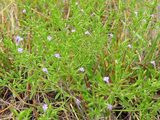Native Plants

Q. Who is Mr. Smarty Plants?
A: There are those who suspect Wildflower Center volunteers are the culpable and capable culprits. Yet, others think staff members play some, albeit small, role. You can torture us with your plant questions, but we will never reveal the Green Guru's secret identity.
Did you know you can access the Native Plant Information Network with your web-enabled smartphone?
Ask Mr. Smarty Plants is a free service provided by the staff and volunteers at the Lady Bird Johnson Wildflower Center.

rate this answer
Wednesday - February 19, 2014
From: Rosanky, TX
Region: Southwest
Topic: Erosion Control, Groundcovers, Grasses or Grass-like
Title: Native plants and grasses for river bank from Rosanky TX
Answered by: Barbara Medford
QUESTION:
Our property owners association would like to know what native plants/grasses to plant on the Blanco River bank in our river park to help prevent erosion. Some banks are steep and some areas are a gradual slope. Members want to know if it is preferable to leave downed trees and flood debris where they fall to prevent future erosion or if the better plan is to remove them and plant new trees and grasses. Our main goals are to protect our riverbank while also making sure property owners have access to enter the river and enjoy the water. Thank you for your help!ANSWER:
To answer your last question first, we would never recommend leaving debris, including fallen trees, on the ground. After all, you are in Bastrop County, and we understand we are already entering a period of Fire Danger warnings in Central Texas. Plus, it would be more difficult to plant and care for groundcovers with that debris present.
You mentioned steep banks but did not tell us about the sunlight available, so we are going to do a combination search on our Native Plant Database for groundcovers - some will be low and some will be high, so you will need to follow each plant link to our webpage on that plant, paying special attention to the growing conditions of each. We will check each to make sure it is native to your area before we add it to the list. Follow each plant link to our webpage on that plant, comparing water needs, size and growing conditions with what you are looking for.
First, some groundcovers that will do all right without too much sun - From a previous Mr. Smarty Plants answer for Austin:
Low groundcovers for part shade to shade in Central Texas:
Carex planostachys (Cedar sedge)
Low herbaceous blooming plants for part shade to shade in Central Texas.
Amblyolepis setigera (Huisache daisy)
Callirhoe involucrata (Winecup)
Calyptocarpus vialis (Straggler daisy)
Chamaecrista fasciculata (Partridge pea)
Dichondra argentea (Silver ponyfoot)
Glandularia bipinnatifida (Purple prairie verbena)
Hedeoma drummondii (Drummond's false pennyroyal)
Now, here are some taller grasses, for varying amounts of sun:
Andropogon gerardii (Big bluestem)
Aristida purpurea (Purple threeawn)
From the Image Gallery
More Erosion Control Questions
Erosion control near creek in Kansas City, MO
July 26, 2008 - I'm looking for something to plant to help stop erosion on my property. The spot I have in mind is on a slight natural grade heading toward the creek at the back of my property. Any ideas on what t...
view the full question and answer
Plants for erosion control in horse pasture
April 26, 2010 - I have erosion on a slope, southwestern facing, minimal shade in Palos Verdes Peninsula, CA. The soil is rocky and clayish. The hillside is in the middle of a horse paddock and barn. What plants woul...
view the full question and answer
Phytoremediation using Paspalum vaginatum
February 06, 2015 - Do you know of any on-going research using Paspalum vaginatum as the prime plant (monoculture) for use in phytoremediation.
Utilizing this plant in Vegetated Swales, Spreader Swales, Grassy Swales,...
view the full question and answer
Plants to prevent erosion on slope in Texas
June 19, 2010 - We have an erosion problem developing on the low side of a gently sloping hill. We are in clay soil at the base of the hill with oaks and pines. We have a right of way that is without trees forty fee...
view the full question and answer
Limiting erosion around pond from Brooklyn Park MN
May 20, 2013 - Minnesota resident, wants to find plant limit erosion from pond?
view the full question and answer
| Support the Wildflower Center by Donating Online or Becoming a Member today. |

